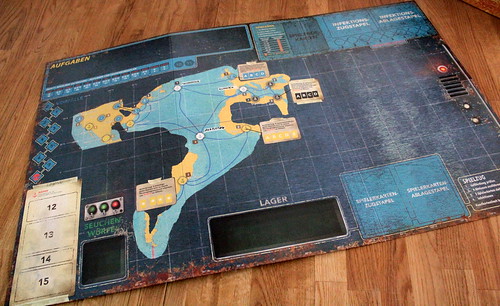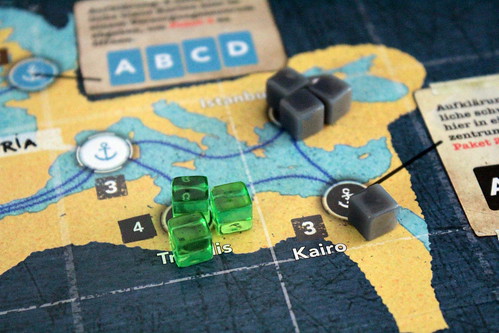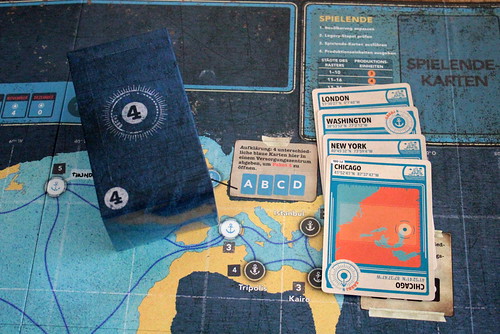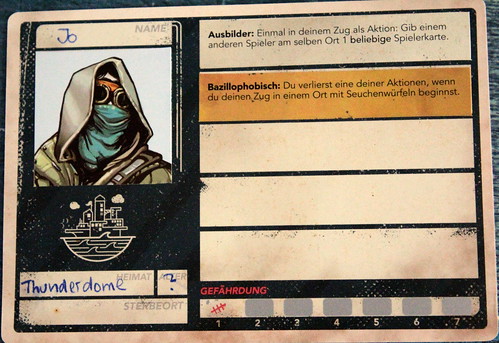| Strategy | Luck |
|---|---|
| Interaction | Components & Design |
| Complexity | Score |
Warning! This review will contain spoilers for Pandemic Legacy Season 1 and very minor spoilers for Season 2.
The big question after Pandemic Legacy Season 1 was: How will Season 2 start? Will it assume that we saved the world? That we didn’t? How do you start a second season when everyone’s first season had a different ending?As it turns out, Matt Leacock and Rob Daviau didn’t have to make that decision, after all. Season 2 starts 71 years after a terrible disease devastates the world. However, it wasn’t the disease that we stopped – or failed to stop – in Season 1. It was the one that struck right after. And just like that, it doesn’t matter how well you did in Season 1, Season 2 puts everyone in the same place.
That place being the three Havens, swimming cities far away from the coasts, two in the Atlantic Ocean, one in the Mediterranean. They are the major remnants of civilization, supplying what remains of some coastal cities with food and medication.
There are multiple problems for you to solve. One, you have lost contact with all but the last few settlements on dry land. Two, your leaders and security expert have gone to a meeting and never returned. Three, supplies are growing thin and the disease seems to be growing resistant to your medication.
How to play Pandemic after the apocalypse
I’m going to assume some familiarity with Pandemic Legacy here. No one wants me to explain the same game over and over. The structure of Season 2 is exactly the same as Season 1. The plot is split into twelve months, and for each month you have two chances to win. If you don’t make it the second time, the plot still continues but might not leave you in the best position.
The turn structure remains equally unchanged. The active player has four actions, then they draw two cards, then they turn two or more cards from the infection deck and remove cubes from the cities on those cards.
You read that right, remove cubes. You’re no longer adding disease cubes to the board, now you’re removing supply cubes. Only when a city is out of supplies and comes out of the infection pile again do you add a plague cube. There’s only one color of those now, and there are only eight of them. When you used them all it’s game over.
The other big, big problem with plague cubes is that you don’t want your pawns to start in a city with one of those. If they do you have to open a space on the Exposure track on your character card. You can get lucky there and have nothing bad happen to you, but negative effects include Scars – negative effects for your character – and Death. It’s especially insidious that Death might not be the last space on the track. “I can take the Exposure, I have three Exposures left,” is a very dangerous thing to say.
So, yay, lots of bad things happening. What can we do to make them stop? Just like everything else, the basic player actions are immediately recognizable to Pandemic veterans. For an action, you can move into a neighboring city or Haven. You can discard the card of a destination city to travel there directly, or a card of your current city to travel to any other city. Well, not quite any. Air travel doesn’t exist any more. Playing cards to travel now means you go by boat, and that means it only works for coastal cities and only if you know a sea route from here to there.
You still have to collect sets of five player cards to reach the default goal, which is now to build three supply centers, one on each of the three colored regions you know at the start of the campaign. Discard five cards of the same color as your current city and you may build one. Trading cards with other players also works the same, you have to be in the city matching the card to be able to trade it.
Treating infections no longer exists as an action, the plague is not treatable. Instead, you now deliver supplies by placing supply cubes from your character card in your location. Before you can deliver them you must produce them. You can use the Make Supplies action anywhere to create a supply cube. It’s much more effective to Produce Supplies with one of the special cards for that purpose. Playing one of those you fill your location with cubes, up to its current population. As free actions, you may pick up supply cubes from the board or trade them with another player.
Those Produce Supplies cards are also your first contact with a welcome change in Season Two: Your actions have a wider range of long term consequences. Your actions will still make cities rise and fall, depending how well you treat them, but there are other ways you change the game. The Produce Supplies card have a variable number of boxes to mark. When you do that you produce supplies in all Havens and supply centers up to their capacity. However, when the last box on a card is marked you destroy it.
There is one more, new way in which you change the game, which is the last action. When you start the game, you literally only know the coast of the Atlantic Ocean and the Mediterranean. The rest of the world map is blank. Discarding the right set of cards in one of the four marked locations lets you put a sticker on the board with more of the map and thus rediscover the world bit by bit.
At the end of each game you still make more changes to the game, these ones more familiar again. Cities with a supply center grow, cities with disease cubes decline until they are, eventually abandoned. You also get a number of points to buy upgrades. New character abilities, special effects on player or infection cards, bolster a cities population, and many more you discover as the campaign progresses.
But what does it all mean?
Let me get one thing out of the way. When I first read the introduction to Season 2 I was disappointed. After all our efforts in Season 1 the world still ended. I can see it had to be like that, if we had turned the world into a Utopia free of diseases there wouldn’t be a Season 2. Still, I wanted something to carry over from Season 1, even if it was only something minor that wouldn’t affect those who didn’t play Season 1. But no, nothing we did in the first game mattered.
I got over that disappointment quickly, because Season 2 is a work of genius. It has a superb mix of familiar mechanics for old hands to feel at home with new elements to make you rethink what you’re doing.
What’s more, and this is what really elevates Season 2 above the excellent Season 1 for me, are the more ways you affect how the game develops. I already mentioned the Produce Supplies card above, but there’s more. Careful, this is going to be the one, real spoiler. When you rediscover more of the world you gain the ability to build connections between cities. The rediscovered cities have no connections at first, you have build the roads and map the sea routes. You have to build your own infrastructure, and planning and investing here can make later games much easier.
I guess that’s all I have to say. I liked Season 2 even more than Season 1, and I didn’t expect to like anything more than Season 1. So what if if grabs deeply into the bag of post-apocalyptic cliches? Season 1 had zombies, and it was still awesome. Season 2 is awesomer. End of story. Or… is it? Has anyone heard talk about Season 3?













